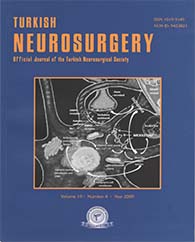4,6İnönü University, Radiology Department, Malatya, Turkey AIM: Although an aneurysmal rupture typically presents on computed tomography (CT) imaging as only a subarachnoid hemorrhage (SAH), it may be associated with spontaneous (nontraumatic) subdural hemorrhage (sSDH). The purpose of this paper is to discuss the clinical and radiological characteristics, as well as a potentially dangerous situation in the diagnosis and the management of this life-threatening condition.
MATERIAL and METHODS: The Department of Neurosurgery at Inonu University (Turgut Özal Medical Center) (TOMC) maintains a prospective database of all patients treated for intracranial aneurysms since 1999. Using this database, we obtained patients with ruptured aneurysms who presented with sSDH on CT imaging.
RESULTS: 687 patients with radiographically documented ruptured aneurysms were admitted from January 2000 through January 2009. Of these, eleven patients presented with sSDH. The incidence of aneurysmal rupture with sSDH is 1.6 % in our series.
CONCLUSION: Acute sSDH on cranial CT should be considered for an urgent workup of a ruptured aneurysm, even in the absence or presence of SAH finding. CT angiography has advantages over cerebral digital substraction angiography (DSA) and may be a reasonable alternative to latter modality in the diagnosis, triage, and treatment planning in patients with sSDH.
Keywords : Acute subdural hematoma, Intracranial aneurysm rupture, Subarachnoid hemorrhage




